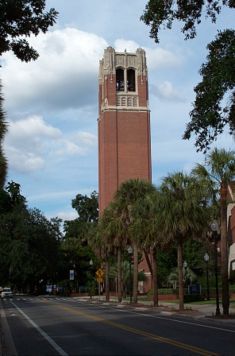About The University
The University of Florida (Florida or UF)
is a public land-grant research university
located in Gainesville,
Florida. The school, which officially
became the University of Florida in 1905,
traces its institutional roots to 1853.
It is the fourth-largest university in
the United States, with 49,693 students
(34,612 undergraduates and 15,081 postgraduates),
and has the eighth-largest budget (nearly
$1.9 billion per year). Florida ranked second
among all institutions in the number of
National Merit Scholar students enrolled,
behind Harvard. It is also the place where
Gatorade was created. |
|
Florida is the flagship institution of the State
University System of Florida. Its undergraduate
progam is currently ranked by U.S. News &
World Report as first in the state of Florida,
13th among U.S. public universities, and 47th
overall. Listed as a Public Ivy, Florida is a
member of the Association of American Universities.
The 2006 Academic Ranking of World Universities
list assessed Florida as 53rd among world universities
based on research output and faculty awards.
Florida is also noted for its strong NCAA programs.
Its mascot is the alligator, and its intercollegiate
sports teams are referred to as the Florida Gators.
It has a faculty of about 5,000.
History
The 1905 Buckman Act created the current
University of Florida in its reorganization
of the state public state higher education
system through consolidating all of the
existing white men's educational institutions.
The Buckman Act provided for the merger
of several institutions into the new University
of the State of Florida: the University
of Florida at Lake City (formerly Florida
Agricultural College), the East Florida
Seminary in Gainesville, the St. Petersburg
Normal and Industrial School at St. Petersburg
and the South Florida Military College at
Bartow.(The act also designated Florida
State University as a women's university
and the State Normal School For Colored
Students–now Florida A&M University
and a historically-black university–as
a postsecondary institution). |

Century Tower,
University Of Florida
|
On July 6, 1905, the state legislature selected
Gainesville for a new university campus. Andrew
Sledd from the University of Florida at Lake City
became the first president, while architect William
A. Edwards designed the first campus buildings
in the collegiate gothic style. Classes began
on September 26, 1906. In 1909 the name was shortened
to the University of Florida.

Official Seal
University Of Florida
|
The year 1905 was considered the university's
official founding date until 1935, when the
date was changed to 1853 by Attorney General
Cary D. Landis at the request of UF's third
president John J. Tigert. 1853 is the founding
date of the East Florida Seminary in Ocala,
the earliest founded institution of the colleges
which became the University of Florida. The
East Florida Seminary had an unusual history
in its short existence. It was founded in
Ocala by Gilbert Kingsbury to take advantage
of legislation passed in 1851 to establish
the creation of two seminaries. It briefly
closed during the Civil War and reopened in
Gainesville having been moved by an act of
the Legislature in 1866, and finally ended
up being assimilated into the modern University
of Florida created by the Buckman Act. |
The Buckman Act established the University of
Florida as the only public school in Florida for
white males. In 1947, UF began allowing women
to enroll. Admission of African-American students
began in 1958.
Shands Hospital at UF first opened in 1958 along
with the medical school. Rapid campus expansion
began in the 1950s and continues to the present.
In 1985, Florida became a member of the Association
of American Universities (AAU), the prestigious
higher-education organization comprised of the
top 62 public and private institutions in North
America. UF is one of only 17 public, land-grant
universities that belongs to the association.
Throughout the 1950s, UF was one of the Florida
universities that was the target of an ongoing
investigation by a McCarthyist committee of the
state legislature, headed by Charley Johns, which
resulted in a number of LGBT students' and faculty
members' being ousted from the University and
the publication of the Purple Pamphlet.
The alligator was chosen as the school mascot
in 1911. The school colors, blue and orange, are
thought to have come from both the Blue and White
of the University of Florida at Lake City and
the Orange and Black of East Florida Seminary
at Gainesville.
Academics
UF is divided into sixteen colleges, which
offer over 100 undergraduate majors and 200
graduate degrees, including the only public
pharmacy, dentistry, and veterinary medicine
programs in the state. The centerpiece of
the journalism programs at UF is WUFT, which
consists of both a PBS television station
and an NPR radio station. The commercial radio
station, WRUF AM850, is also one of the oldest
stations in the state. |

Marston Science Library,
University Of Florida
|
The acceptance rate at UF has trended downward
as the applicant pool has become more competitive.
The university has a freshmen retention rate of
over 90%.
National Merit Scholars, as of the Fall 2007
term, are no longer being offered a competitive
academic scholarship upon enrolling at UF. In
past years, the university heavily recruited National
Merit Scholars by offering $5,500 per academic
year in scholarships, as well as a single $2,000
research stipend for summer study. According to
Provost Fouke, recruitment of National Merit Scholars
over the past several years has been "too
successful" and the financial burden of providing
the best-qualified students with substantial academic
scholarships has become prohibitive for the University
of Florida. Accordingly, that scholarship package
has now been reduced to $1,000 per year plus a
single $1,000 research stipend for a total of
$5,000 over four years. Fouke has also publicly
stated that the academic records of "other
high-achieving students" not earning National
Merit recognition compare favorably to those of
National Merit Finalists at UF, indicating a reduced
emphasis on National Merit recruitment by the
University. It is expected that the number of
enrolled National Merit Scholars will decrease
due to the this reduction.
The University of Florida is home to an Honors
College that offers many honors courses to students
who earned SAT/ACT scores of 1400/33 or above.
The Honors program lasts for a student's first
two years, but Honors program services and courses
remain available to upperclassmen. Honors students
must complete four honors courses to be awarded
an A.A. degree with honors or high honors. Honors
at the bachelors degree level are determined by
rules set by the student's College and major.
The university is 13th among all universities
- public and private - in the number of U.S. Patents
awarded in 2000.
source: wikipedia.org
|